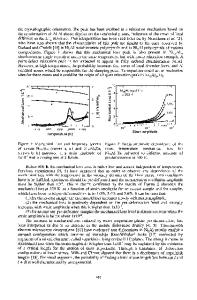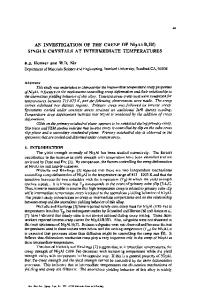Dislocation Dynamics Studied by Mechanical Loss in a Ni 3 (Al, Ta) Single Crystal at Intermediate Temperatures
- PDF / 351,942 Bytes
- 5 Pages / 418.5 x 645.3 pts Page_size
- 71 Downloads / 310 Views
ABSTRACT Dislocation dynamics in Ni 3AI intermetallic single crystals has been studied by mechanical spectroscopy between 300 and 700 K. It has been found that in the anomaly domain of the flow stress, which is characteristic of this material, the mechanical loss of predeformed specimens is strongly dependent on strain amplitude, predeformation level, annealing temperature and time. The results can be interpreted as a combination of two phenomena which simultaneously occur as temperature is increased from 300 K to about 500 K: exhaustion of the mobile dislocation segments (superkinks) and pinning of the screw dislocation segments via cross-slip from the (111) onto the (010) planes. INTRODUCTION A detailed study of the Ni, 5Al4Ta1 intermetallic compound by using the mechanical spectroscopy technique [1] has shown that the mechanical loss vs. temperature spectrum between 300 K and 1300 K presents a well-defined peak located at about 950 K (for a frequency of 1 Hz) which is superimposed on a mechanical loss background which exponentially increases at high temperatures [2]. The mechanical loss peak has been interpreted as resulting from a short range diffusion process leading to the stress re-orientation of Al-Al elastic dipoles in the (111) octahedral plane, that is indicative of the onset of local diffusion in the L12 structure. The high temperature mechanical loss background could be attributed to the dislocation motion on the {001 1 cube planes. Several models have been proposed to interpret the flow stress anomaly of L12 intermetallic alloys as resulting from a cross-slip mechanism from the primary octahedral plane onto the cube crossslip plane (for a review see [3]). Depending on the dislocation dynamics which are considered in the models, this cross-slip process leads to a decrease in the mobility and/or in the dislocation density, which control plastic flow. Since this cross-slip mechanism is thermally activated, it is therefore expected with increasing temperature a decrease in either dislocation mobility and/or mobile dislocation density, or both, yielding the flow stress anomaly. The present paper reports the main characteristics of mechanical loss and dynamic shear modulus spectra obtained in the temperature range of the flow stress anomaly, 300 K to 700 K, on virgin and predeformed Ni 75A124Ta1 single crystals. Various pre-straining conditions, together with thermal cycling, have been used. The results are interpreted on the basis of dislocation motion and locking by the formation of Kear-Wilsdorf locks [4]. EXPERIMENTAL The studied material is a Ni 3(A1,Ta) single crystal with nominal composition Ni75A124Ta1 , supplied by Prof. D. P. Pope at the University of Pennsylvania, USA. Parallelepipedic specimens (25 mm x 2 mm x 0.45 mm) oriented along and with and lateral faces have been prepared KK5.38.1 Mat. Res. Soc. Symp. Proc. Vol. 552 © 1999 Materials Research Society
by using an electro-discharge machine and further carefully polished with successively finer grades of abrasive papers for removing the sur
Data Loading...











